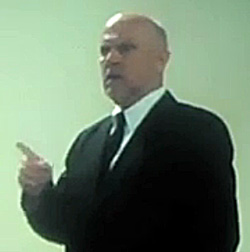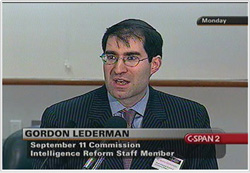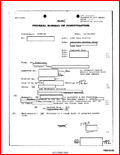Insider Threats: Experts Try to Balance the Constitution with Law Enforcement to Find Terrorists

Counterterrorism instructor, William Gawthrop, giving his now infamous lecture from a screen capture of the video uploaded by Wired magazine.
A few minutes into a lecture on Islamic extremism, counterterrorism instructor William Gawthrop lifts a sheet of paper and asks the class to imagine iron filings on top and a powerful magnet underneath.
“As you move the magnet … you see the iron filings move back and forth,” Gawthrop told law enforcement officers at a June 2011 seminar in downtown Manhattan.
Continuing his analogy, which was captured on video, Gawthrop likens the iron filings to Muslims. But “what we are interested in,” he says, is the magnet, “the radiating force [that Islamic] ideology” exerts on its surroundings.
“That force,” he adds, “is also exerted against you.”
He also says that “this ideology is an engine, and as an engine it produces an output. ... [It] is militant in tone and tenor, has a singular purpose and methodology for advancing itself.”
“We waste a lot of analytic effort talking about the type of weapon, the timing, the tactics,” Gawthrop says. “All of that is irrelevant ... if you have an Islamic motivation for actions.”
When Wired magazine published the video, skeptics called Gawthrop’s lecture simplistic. The former military interrogator who goes by the pseudonym Matthew Alexander told Wired, “The single worst thing we’ve done since 9/11, the one thing that’s harmed us the most in interrogations, is these types of stereotypes.”
Added former CIA analyst Jarret Brachman: “This kind of vitriolic snake oil is not only wrong but it serves to inflame the relations between Muslims and law enforcement, making both communities more suspicious of one another’s real intentions.”
Gawthrop’s seminar isn’t the only effort that has disturbed critics with its bid to target the lure of fundamentalist Islamic beliefs as part of the campaign to apprehend domestic terrorists.
FRAUGHT PHRASES
Last year, the American Civil Liberties Union protested a 2003 FBI memorandum (PDF) from the agency’s San Francisco office seeking renewal of a counterterrorism trainer’s contract. The ACLU, which obtained the memo through a Freedom of Information Act lawsuit, derided the trainer’s lesson plan as filled with racist and derogatory assertions, hyperbole and “outright falsehoods.”
Specifically, the ACLU pointed to such phrases as “the Arab mind is a cluster thinker, while the Western mind tends to be a linear thinker,” and “the mainstream Muslims have always been the silent weak majority within the Islamic faith.”
And, in response to a complaint from Sen. Dick Durbin, D-Ill., the FBI has removed phrases from its training material that said agents had the “ability to bend or suspend the law and impinge on freedoms of others.” The agency also deleted wording, from among 160,000 pages of material, that said Arabs were prone to have “Jekyll & Hyde temper tantrums.”
“Congress has given the FBI the authority to wiretap, collect business records, and gather other forms of information for intelligence purposes, subject to certain safeguards,” University of Texas law professor Robert Chesney told Wired.

Read all the articles in the Patriot Debate series:
WAR POWERS
- • Constitutional Dilemma: The Power to Declare War Is Deeply Rooted in American History by Richard Brust
- • War Powers Belong to the President by John Yoo
- • Only Congress Can Declare War by Louis Fisher
TARGETED KILLINGS
- • Uneasy Targets: How Justifying the Killing of Terrorists Has Become a Major Policy Debate by Richard Brust
- • Targeted Killing Is Lawful If Conducted in Accordance with the Rule of Law by Amos N. Guiora and Monica Hakimi
CYBERWARFARE
- • Cyberattacks: Computer Warfare Looms as Next Big Conflict in International Law by Richard Brust
- • What Is the Role of Lawyers in Cyberwarfare? by Stewart A. Baker and Charles J. Dunlap Jr.
COERCED INTERROGATIONS
- • Probing Questions: Experts Debate the Need to Create Exceptions to Rules on Coerced Confessions by Richard Brust
- • Should We Create Exceptions to Rules Regarding Coerced Interrogation of Terrorism Suspects? by Norman Abrams and Christopher Slobogin
DOMESTIC TERRORISM
- • Insider Threats: Experts Try to Balance the Constitution with Law Enforcement to Find Terrorists by Richard Brust
- • The Threat from Within: What Is the Scope of Homegrown Terrorism? by Gordon Lederman and Kate Martin
THIRD-PARTY DOCTRINE
- • Crashing the Third Party: Experts Weigh How Far the Government Can Go in Reading Your Email by Richard Brust
- • The Data Question: Should the Third-Party Records Doctrine Be Revisited? by Orin Kerr and Greg Nojeim
NATIONAL SECURITY LETTERS
- • Letters of the Law: National Security Letters Help the FBI Stamp Out Terrorism But Some Disapprove by Richard Brust
- • National Security Letters: Building Blocks for Investigations or Intrusive Tools? Michael German and Michelle Richardson, and Valerie Caproni and Steven Siegel
DETENTION POLICY
- • Detention Dilemma: As D.C. Circuit Considers Guantanamo Inmates, Can Judicial Review Harm Military? by Richard Brust
- • Detention Policies: What Role for Judicial Review? by Stephen I. Vladeck and Greg Jacob
But, he added, “it is a severe misstatement to refer to the exercise of these lawful author-ities as ‘bending’ or ‘suspending’ the law; that mischaracterization runs the risk of both delegitimizing these lawful tools and, simultaneously, conveying to agents the mistaken impression that there might be some more general power to disobey the law during intelligence investigations.”

“The scope of the insider threat…
is virtually unprecedented,” Lederman
says in his Patriots Debate essay.
IN SEARCH OF BALANCE
With potential terrorists surfacing in towns across the country, Americans are coming to grips with an age-old battle: how to weigh security with liberty.
Here, the issue is whether the training and intelligence-gathering activities of law enforcement officials are sufficiently balanced against constitutional protections of religious and political thought. And do law enforcement tactics and policies encourage Muslim-Americans to help weed out the troublemakers, or do they encourage continued racial stereotypes?
To Gordon Lederman, chief counsel for national security and investigations of the U.S. Senate Homeland Security and Governmental Affairs Committee, “the scope of the insider threat to the United States in the 21st century is virtually unprecedented.”
According to Lederman, “There exists the potential for an individual within the United States, segregated within his or her own Internet community of sympathizers, to radicalize to violent extremism and then to utilize modern technology to kill millions of people or to hobble critical infrastructure.”
This insider threat, Lederman wrote in his essay in Patriots Debate: Contemporary Issues in National Security Law—an upcoming book by the American Bar Association’s Standing Committee on Law and National Security—“requires a greater emphasis on preventing potentially catastrophic attacks before they occur.”
But to Kate Martin, director since 1992 of the Center for National Security Studies, a nongovernmental advocacy and research group in Washington, D.C., Lederman’s “rhetoric [may] obscure the difficult constitutional issues faced by law enforcement in attempting to prevent acts of domestic terrorism.”
Terms such as violent extremism, she wrote in her response to Lederman, are “imprecise and could encompass extreme beliefs, like belief in the necessity of and moral justification for violence, which are protected by the First Amendment.” Such wordings, Martin wrote, are “constitutionally distinct from violent acts, which are not protected.”
The ABA committee invited Lederman and Martin to join the discussions in the book, scheduled to be published this summer.
Before plunging into the debate, though, it’s necessary to define terms. The chief threat that Lederman identifies is “violent Islamic extremism,” which he describes as “the ideology advocating creation of a global state that would impose the most radical version of Islamic law and the use of violence against non-Muslim military personnel and civilians, and even against Muslim opponents of this ideology.”
To recruit adherents, extremists portray “a narrative that the West, led by the United States, is at war with Islam.” Lederman calls the process “radicalization.”
In fact, terrorism experts have sought to pinpoint exactly where radicalization ends and recruitment begins. That’s the stage, they say, where constitutional protection ought to cease and law enforcement should step in.
“In the United States, to hold radical views is not a crime,” wrote Brian Michael Jenkins, a senior adviser at the RAND Corp., in his 2011 paper Stray Dogs and Virtual Armies: Radicalization and Recruitment to Jihadist Terrorism in the United States Since 9/11. “The Constitution provides strong protection of individual beliefs and free speech,” Jenkins wrote.
“Only when these turn to criminal incitement and violent action or manifest intent to engage in violence is there cause for legal intervention,” he wrote. “This is why analysts favor the complete phrase ‘radicalization and recruitment to terrorist violence.’ It is the second step that makes the first step a matter of concern.”
A 2007 study by the New York City Police Department’s Intelligence Division lists a four-step process of domestic jihadist radicalization.
• First is a pre-radicalization phase, where mostly young males—the target demographic—are largely unaware or uninterested in jihad.
• Next comes “self-identification,” indicated by a crisis or trigger (for example, a job loss, family death or social alienation) that leads them to explore Islam.
• The third step is indoctrination, the adoption of jihadist ideas. Typically a charismatic figure, or “spiritual sanctioner,” plays a lead role in educating the individual.
• Finally there’s “jihad-ization,” where they identify themselves as jihadists.

Kate Martin speaks out against the
focus on ideology instead of actions.
VARIATIONS ON THE THEME
One expert, however, warns against viewing radicalization as a standard “conveyor belt.” Some individuals never radicalize, while others skip steps, said Jerome P. Bjelopera, a specialist in organized crime and terrorism, in his November 2011 Congressional Research Service report, American Jihadist Terrorism: Combating a Complex Threat.
Nevertheless, Bjelopera said, since May 2009 there have been 32 cases of homegrown violent Islamic extremism by either American citizens, legal permanent residents or visitors radicalized in the U.S. The individuals tend to be men of an average age of 32. Many started college but dropped out to join the jihadist cause. And many spent time abroad, an important step in motivation and know-how, Jenkins wrote in his report.
Observers characterize these American jihadists as “lone wolves,” who split from Islamism and go off to hunt on their own. But Jenkins shuns that analogy, implying that these are not renegade predators who boldly leave the pack to perform a loathsome job.
Instead, he prefers to describe them as “stray dogs,” estranged from but depending on society, “streetwise but lacking social skills, barking defiantly and potentially dangerous but at the same time suspicious, fearful, skittish.” They “sniff ... at the edges of violence before making a move. Most are arrested before they get that far,” Jenkins wrote.
But what makes the current brand of recruitment so dangerous and elusive is the popularity of the Internet, which peers into bedrooms and lures the disaffected. Violent Islamic extremists have become adept at using it to spread their propaganda, Lederman said.
Ultimately, he wrote, the Internet “enables individuals who are vulnerable to radicalization to find violent … material easily and to self-segregate and interact only with individuals who share that ideology—and in the privacy of their own homes.”
In a phone interview, Lederman adds that “it’s not really a numbers game. The danger is when you combine [potential terrorists] with access to weapons of mass destruction. It’s a more dangerous mix than it was years ago. Now one person can realize a large amount of damage.”
An expert on national security, Lederman was director of legal affairs for the Project on National Security Reform—a nonpartisan, nonprofit initiative funded by Congress and the White House to recommend reorganization of the government to meet national security threats. A former counsel for the 9/11 Commission, Lederman also worked at Arnold & Porter and White & Case.
Said Jenkins: “Given the operational re-quirements of clandestinity, which preclude traditional press conferences, face-to-face interviews and physical broadcasting or printing facilities, and keeping in mind al-Qaida’s youthful audience, it is hardly surprising that the Internet has become the primary vehicle for disseminating the organization’s propaganda and operational guidance.”
And yet recruitment has been scarce. “Despite al-Qaida’s intensive online recruiting campaign,” Jenkins wrote, “their numbers are small, their determination limp and their competence poor.”
While the Internet may be a source of inspiration, he wrote, it is also a “substitute for action, allowing would-be terrorists to safely engage in vicarious terrorism while avoiding the risks of real action.” For al-Qaida, it’s a “virtual army that thus far has remained virtual.”
To Martin, that indicates a lack of “consensus that the experience to date of plots in fact supports such dire predictions.”
She also decries government bias against Islam, criticizing “false and bigoted law enforcement training materials and widespread surveillance of mosques,” suggesting “at a minimum, the absence of a clear understanding of constitutional limits.”
Martin served as litigation director for the Center for National Security Studies when it was a joint project of the ACLU and the Fund for Peace. From 1995 to 1999, she was also co-director of a project on security services in a constitutional democracy in 12 former communist countries. She has taught at Georgetown law school and served as general counsel to the National Security Archive, a research library at George Washington University.
Lederman and Martin disagree over the Federal Bureau of Investigation’s use of assessments, intelligence-driven information files identifying potential national security threats.
The FBI initiated the program with its 2008 Domestic Investigations and Operations Guide. According to the guide, agents may begin an assessment without a “particular factual prediction” that a crime has been committed.
Assessments allow agents to use potentially intrusive techniques, such as sending confidential informants to infiltrate organizations, and follow and photograph targets in public, according to a New York Times report.
While Lederman acknowledges the “risk of abuse,” he nevertheless identifies three advantages:
• Agents and other law enforcement officers will need to be trained to recognize “behavioral indicators or radicalization,” rather than attack the idea of Islamic extremism.
• The assessments require oversight by the Justice Department.
• And the effort must coincide with a “vigorous U.S. government outreach” to build relationships with local communities and with Muslim-Americans.
“The other parts of government need to play a greater role,” Lederman says. “It’s not just the FBI’s role to deal with community leaders; other parts of government also need to deal with communities.”
He adds that there needs to be “a coordination across agencies so that the left hand knows what the right hand is doing.”
But Martin worries that the assessments are “no longer confined to investigations of terrorist plots.” Instead, she wrote, they now allow for the “ill-defined, but extremely broad, purpose of ‘foreign intelligence’ gathering.”
SHIFT OF FOCUS
What primarily concerns Martin is the focus on ideology “rather than actions.”
“My first question,” says Martin in a phone interview, “is how are we training our law enforcement about the tenets of religion? We have gotten away from training them about how to plan a terror attack. The two things are not related.”
She adds, “If the individual takes a step beyond belief, and purchases a weapon, that might be grounds to make an investigation.”
Martin, who testified in 2008 before the Senate Select Committee on Intelligence on changes to the FBI guidelines, says she questioned the use of undercover informants in political groups or places of worship.
“The current rules are inadequate,” she says, “because they do not require any kind of factual predicate; there’s no outside oversight, and no notice that a political group will know that there is an FBI agent in their midst.” She adds that “in the last 30 years it has gotten much cheaper and easier for government to do surveillance in many more places.”
“The policymakers in Washington have insufficient understanding of how chilled Muslim-Americans are of practicing religion and expressing their views,” Martin says. “Many believe that by simply going to a mosque they might be sitting next to an FBI agent. It is totally corrosive of the American ethos of who we are as a nation.”
Jenkins acknowledged that “Muslim-Americans understandably resent close scrutiny by authorities, arguing that their religion or ethnicity ought not to make them targets of intelligence or greater scrutiny for security.”
But, he wrote, “while discrimination is contrary to American values and law, the social geography of intelligence collection is dictated by the nature of the threat.”
Lederman points to the interceding of a recent al-Qaida attempt to board a bomb on a jetliner. “It shows that al-Qaida and other individuals still have a desire to attack the U.S. with weapons of mass destruction and cyberweapons,” he says. “It’s a very concerning situation—the marriage of individuals with destructive power.”
Martin wrote that she doesn’t “deny the existence of domestic terrorism and its lethal consequences.” But, she continued, “the magnitude of the threat matters in deciding what kind and level of resources should be used, what trade-offs should be made and how government should be structured.”
But Martin said she feared the “failure to highlight the answer embedded in our constitutional structure: more speech.”
“What’s been lost in the current debate and FBI rules,” she says in an interview, “is sensitivity to the problem of how you investigate crime that’s motivated by political or religious ideology.”
Said Jenkins: “Despite concerns expressed by some, the vast majority of America’s Muslim immigrants have assimilated into American society, where, for the most part, they are doing well.”
“America,” Jenkins added, “still works.”





